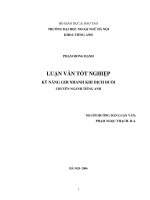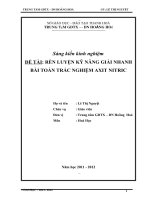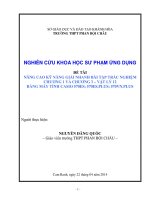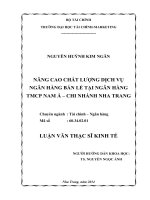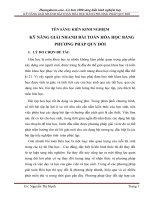KỸ NĂNG GHI NHANH KHI DỊCH ĐUỔI - NOTE-TAKING IN CONSECUTIVE INTERPRETING
Bạn đang xem bản rút gọn của tài liệu. Xem và tải ngay bản đầy đủ của tài liệu tại đây (554.74 KB, 61 trang )
BỘ GIÁO DỤC & ĐÀO TẠO
TRƯỜNG ĐẠI HỌC NGOẠI NGỮ HÀ NỘI
KHOA TIẾNG ANH
PHẠM HỒNG HẠNH
LUẬN VĂN TỐT NGHIỆP
KỸ NĂNG GHI NHANH KHI DỊCH ĐUỔI
CHUYÊN NGÀNH TIẾNG ANH
NGƯỜI HƯỚNG DẪN LUẬN VĂN:
PHẠM NGỌC THẠCH- B.A.
HÀ NỘI- 2006
1
MINISTRY OF EDUCATION AND TRAINING
HANOI UNIVERSITY OF FOREIGN STUDIES
ENGLISH DEPARTMENT
PHAM HONG HANH
GRADUATION PAPER
NOTE-TAKING IN CONSECUTIVE INTERPRETING
ENGLISH
SUPERVISOR:
PHAM NGOC THACH- B.A.
HANOI- 2006
2
ACK NO W L E D G E M E NT
First of all I would like to thank Management Board of the English Department for giving
me a great opportunity to make a research on the subject of note-taking in consecutive
interpreting.
My thanks also go to all lecturers of the English Department of Translation and
Interpreting Studies who taught me many valuable lessons on interpreting in general and
note-taking skill in particular.
I especially would like to express my grateful thanks to my supervisor- Pham Ngoc Thach
who supported me in developing ideas for this paper, agreed to read the manuscript and
made a number of very useful comments.
Finally I would like to thank the students who willingly took part in the survey of this
paper.
3
LIST OF CONTENTS
CHAPTER ONE: INTRODUCTION ………………………………….6
1.1. Background to the Thesis ……………………………………………..6
1.2. Organization of the Thesis …………………………………………….7
CHAPTER TWO: REVIEW OF THE LITERATURE ………….…..9
2.1. Introduction ………………………………………………………….. 9
2.2. Interpreting …………………………………………………………… 9
2.3. Consecutive Interpreting …………………………………………….. 11
2.4. The Role of Note-taking in Consecutive Interpreting ……………… 13
2.5. Note-taking Process in Consecutive Interpreting ……………………14
2.6. What to Note ………………………………………………………….. 15
2.6.1. Main Ideas ………………………………………………….. 16
2.6.2. The Links …………………………………………………… 16
2.6.3. Noncontextualized Information …………………………… 17
2.6.4. Verb Tenses ………………………………………………… 17
2.7. How to Note …………………………………………………………… 18
2.7.1. Abbreviations and Symbols ……………………………….. 18
2.7.1.1. Abbreviations ……………………………………… 19
2.7.1.2. Symbols ……………………………………………. 24
2.7.2. Note Arrangement …………………………………………. 28
2.7.2.1. Layout Diagonal ………………………………….. . 28
2.7.2.2. Left-hand Margin …………………………………. 30
2.8. Which Language Used in Notes ……………………………………… 33
2.9. When to Note …………………………………………………………. 33
4
CHAPTER THREE: METHODS and PROCEDURES …………….. 35
3.1. Introduction ………………………………………………………….. 35
3.2. The Objective of the Survey …………………………………………. 35
3.3. Subjects ……………………………………………………………….. 35
3.4. Methodology and Method of the Survey …………………………… 36
3.4.1. Methodology ………………………………………………… 36
3.4.2. Method ……………………………………………………… 36
3.5. Procedures ……………………………………………………………. 36
CHAPTER FOUR: RESULTS and DISCUSSION ……………….
38
4.1. Introduction ………………………………………………………….. 38
4.2. Findings and Disscusion …………………………………………….. 36
4.2.1. The Role of Note-taking in Consecutive Interpreting ……. 38
4.2.2. What to note ………………………………………………… 44
4.2.3. How to Note ………………………………………………… 47
4.2.4. When to Note ……………………………………………….. 50
CHAPTER FIVE: SUGGESTIONS and CONCLUSION ……….
53
5.1. Suggestions …………………………………………………………… 53
5.2. Conclusion …………………………………………………………… 54
BIBLIOGRAPHICAL REFERENCES ……………………………... 56
APPENDIXES …………………………………………………………. 58
5
CHAPTER ONE: INTRODUCTION
1.1.
Background to the Thesis
Interpreting, like playing chess, is a game of problem solving, evaluation, critical
thinking, intuition and forecasting. Every game is different and each game is a challenge,
which requires interpreters, to unceasingly develop knowledge and experience. It is
disciplined study and repeated practice of many techniques and skills that bring victory to
the interpreter. Apart from basic requirements of language mastery and culture sensitivity,
there are quite a few skills that need to be acquired for successful interpreting. One of
them is note-taking skill.
Taking notes simply means quickly writing down information as a record or reminder.
However, note-taking might be compared with a move in chess; to understand how to
make the move is quite easy, but to master it in order to create a winning combination of
the move and the others is a hard and demanding job.
Note-taking in consecutive interpreting is a skill to be learned. There is no abstract theory
about the skill, but there are a wide range of practical principles laid down by succeeding
generations of consecutive interpreters over time. These principles have been made of
both empirical studies digging deep into nearly every aspect of the skill and research
books elaborating main theoretical approaches to it. By no means exhaustive, the
ambition of this thesis is only to actively, effectively and directly contribute to the further
research, development and implementation of note-taking in consecutive interpreting. The
thesis can be seen as an overall picture that helps student interpreters to have a general
view of fundamental things about the skill and also to explore “the shape” of the notetaking in other novices’ points of view.
6
This thesis is a methodical investigation into the subject of note-taking in consecutive
interpreting; a focused and systematic request for information that may go beyond
generally available knowledge to acquire more in-depth analysis and elucidatory
comment on the topic. It is a product of a long searching process with a series of activities
unfolding over time. It involves a number of things such as the collection of data, the
evaluation of results, and so on.
However, this thesis should not be considered a “millennium project” for the fact that as
the writer, I have not been exposed to any practical experience. My awareness of notetaking skill has been mainly gained through printed and electronic reference material as
well as the suggestions and recommendations by interpreting teachers at the university.
The intended audience will be students of foreign language universities and colleges who
may wish to read a detailed depiction of some background knowledge about note-taking
skill and may be eager to understand the viewpoints of other fellow students on the skill.
Hence, first of all, this paper will hopefully provide them with an overview of notetaking. Secondly, it can also be of some use to those who wish to become interpreters in
the future.
1.2.
Organization of the Thesis
The thesis is organized as follows. It is divided into two different sections. The first
section is for literature review. The purpose of literature review is to analyze critically a
segment of relevant published works through classification and comparison of previous
research studies and theoritical articles. It combines both summary and synthesis. And it
traces back the academic developments and intellectual progression in the field. For its
importance, the literature review deserves the whole chapter 2 for its representation.
7
The second section is all about an empirical study drawing on the findings from a survey.
This section is split into three chapters. Methods and Procedures of the survey will be
discussed in chapter 3. Survey Results and Disscusions will appear in chapter 4.
Suggestions for futher study along with Conclusion will be revealed in the last chapterchapter 5.
The ideas developed in this thesis will not be of purely theoretical interest. They are
expected to have pratical impact on the way note-taking skill for consecutive interperting
is learnt and practised by interpreting students. For that reason, the thesis will be much of
interest to the readers.
8
CHAPTER TWO: REVIEW OF THE LITERATURE
2.1.
Introduction
Literature review is an account of what has been published on a topic by accredited
scholars and researchers but not simply a new interpretation of old material. Therefore,
this chapter is intended not only to demonstrate relevant information on note-taking in
consecutive interpreting but also to provide informed evaluation of the literature. This
chapter explains various aspects related to the topic of note-taking in succession ranging
from panorama view to close-up view. It is started with a brief description of interpreting,
interpreting classification, then a focus on consecutive interpreting and the rest of the
chapter completely zooms in note-taking skill.
2.2.
Interpreting
In order to give a clear definition of interpreting, it is useful to relate it to another activity
for which interpreting is often mistaken- translation. A straightforward explanation of
translation given by Catford (1965, p.11) can help even non-professionals have an overall
picture of what translation is. He simply described translation as an “operation performed
on languages, a process of substituting a text in one language for a text in another”.
Another definition of translation put forward by Edmond Cary (1985, p. 85), as cited in
Lederer, 2003, on page 7, has received the approval from many linguistic theorists.
Translation is a process which attempts to establish equivalents between
two texts expressed in two different languages. These equivalents are,
by definition, always dependent on the nature of the two texts, on their objectives,
on the relationship between the two cultures involved and their moral, intellectual
and emotional conditions.
What is Interpreting? To arrive at a convincing answer to this question, Roderick Jones, a
European Union senior conference interpreter, did not set up a “standard” definition of
9
interpreting. He only stated that interpreting is “immediate oral translation” (2002, p.3).
Interpreting, just like translation, is fundamentally the art of re-expressing. The interpreter
listens to a speaker in one language, gets the content of what is being said, and then
immediately verbally re-expresses his or her understanding of the meaning in another
language.
From other angle, Cynthia Roy (2000, p.3) applied the linguistic approaches of discourse
analysis to the analytical study of interpreting in her book entitled Interpreting as a
discourse process. She said, “Interpreting for people who do not speak a common
language is a linguistic and social act of communication”. That means interpreting is a
process of conversational exchanges between two primary speakers and through a person
called interpreter who has knowledge and understanding of the entire communicative
situation, including fluency in languages, competence in appropriate usage within each
language, and in managing the cross-cultural flow of talk.
It is obvious that both interpreting and translation “…consist of understanding an original
text, deverbalizing its linguistic form and then expressing in another language [with] the
ideas grasped and emotion felt…” (Marianne Lederer, 2003, p.8), however, while
translation refers to converting a written text from one language into another, interpreting
refers to orally converting one spoken language into another.
Both interpreters and translators are required to have a good command of the native
language and at least a foreign language, analytical ability, high concentration, subject
matter knowledge and sensitivity to cultural issues. However, there are different sets of
indispensable skills for each. While a translator must also be sharp writer and skilled
editor, it is important for an interpreter to have extraordinary listening abilities,
exceptionally good memory aided by good note-taking techniques and excellent public
speaking skills. In addition, interpreters must have intellectual capacity to immediately
transform idioms, colloquialisms and other culturally specific references into similar
10
statements that the target audience can understand without the using dictionaries and
supplemental reference materials. Above all, unlike translators, interpreters have to deal
with oral message under time constraints without the opportunity of revising, improving
or polishing their interpretation. For these reasons, many people who see interpreters at
work think that being an interpreter is extremely demanding and challenging.
2.3.
Consecutive Interpreting
As far as the classification of interpreting is concerned, most people who get involved
into linguistic study, would give their attention to what is meant by consecutive
interpreting and simultaneous interpreting. In fact, consecutive and simultaneous are the
two sub-types of interpreting, based on the interpreting mode used by the interpreter:
simultaneous, which occurs nearly at the same time as the original utterance of a speech;
consecutive, which follows a chunk of speech varying in length from very few sentences
to an entire speech lasting several minutes.
A more detailed picture of differences between the two main modes of interpreting can be
seen clearly with the definition given by Jones (2002, p.5- 6). He stated that a consecutive
interpreter “listens to the totality of a speaker’s comments, or at least a significant
passage, and then reconstitutes the speech with the help of notes taken while listening; the
interpreter is thus speaking consecutively to the original speaker, hence the name”. And
he explained the second mode as follows: “Here the interpreter listens to the beginning of
the speaker’s comments then begins interpreting while the speech continues, carrying on
throughout the speech, to finish almost at the same time as the original. The interpreter is
thus speaking simultaneously to the original, hence again the name”.
From the above brief description, it is clear that the primary and significant difference
between consecutive interpreting and simultaneous interpreting is the time gap between
the delivery of the speaker’s message and the beginning of the interpretation. However,
11
whether working consecutively or simultaneously, the interpreter first has to actively
listen to the speaker, properly understand and logically analyze what is being said and
then restructure the speech in an appropriate equivalent in a different language.
Wei HeZhong cited on page 1, in the article- Memory Training in Interpreting that Daniel
Gile (1992, 1995) views consecutive interpreting as a process consisting of two separable
phases. The first phase is listening during which the interpreter listens to the sourcelanguage speech and takes notes; the second phase is reformulating, during which the
interpreter reproduce a target- language speech from memory and from notes.
Phase One- Listening Phase:
CI = L (listening) + M (short-term memory) + N (note-taking)
In this phase, the interpreter is required to listen attentively, selectively and actively to the
original speech, then the interpreter’s short-term memory is used to store the messages
that have been heard to put them either in memory or in notes or both. It is easy to
recognize that note-taking is an undivided part of the first phase.
Phase Two- Reformulation Phase:
CI = R (remember) + R (read the notes) + P (produce the speech in the target language)
In the second phase, the interpreter retrieves messages from their memory as well as from
the notes, and produces the speech in the target language.
Consecutive interpreters are said to produce a more accurate and equivalent interpretation
than simultaneous colleagues because “the interpreter does not need to split their
attention between receiving the message, and monitoring their output, as is required in
simultaneous, they can devote more of their processing to analysis and reformulation of
the text” (Santiago, 2004, p.5). Moreover, because consecutive interpreters have time to
take notes which serves as a very effective tool of the interpreters. As introduced in the
12
first chapter, the main focus of the thesis is on the skill of note-taking in consecutive
interpreting.
2.4.
Note-taking in Consecutive Interpreting
During the interpretation process, both memory and notes should be cultivated. While
memory is of crucial to interpreters, notes can be of certain support.
The importance of note-taking in consecutive interpreting had not been well recognized
until Rozan laid down fundamental principles of note-taking in 1956 and Seleskovitch
solidified the benefits of the skill in 1975. Experience has shown that the consecutive
interpretation of speeches that are longer than two or three minutes requires at least some
form of note-taking, of course, this also depends on the interpreter’s personal need,
expertise and familarity with the subject.
Note taking has been proved to be very useful for the interpreter working consecutively.
Firstly, notes improve concentration; prevent distraction, thus facilitating the reception
and analysis of the speech. Secondly, notes help the interpreter relieve the memory.
Although the interpreter may have understood the ideas of a speech, he or she cannot
remember every point in the speech because one characteristic of short-term memory is
that it only keeps information for a limited amount of time, cognitive scientists also show
that for nearly all speakers of all languages, list retention peaks at around seven items,
plus or minus two. By recording the specific details and data such as proper names,
numbers, figures, lists of things, or specialized terms, technical expressions, etc, notes
release the interpreter from bearing the whole thing in mind. Thirdly, as mnemonic, notes
activate the memory of the interpreter with cues or signals that call up the information in
the speech. With notes, the main ideas, the secondary elements and the links among them
become clear and easier for the interpreter to visualize. Finally, notes can also be used to
highlight missing details, inconsistencies within the speech and anything implausible that
13
needs attention latter. Conspicuously, the skill of note-taking is very helpful to
interpreters, the content and structure of a speech are reflected in notes, and the notes in
turn are used as a path to verbalize the speech.
Thus notes play an important part in consecutive interpreting. However, taking proper
notes needs a lot of practice, and the gap between the “theory of note-taking” and “actual
notes” can be very large. In order to bridge the gap, first, an understanding of note-taking
process is required.
2.5.
Note-taking Process in Consecutive Interpreting
According to Jones (2002, p.39), note-taking is part of the whole process of consecutive
interpreting including: understanding, analysis and re-expression, and if these activities
“are not done correctly, the best notes in the world will not make a good interpreter”. It
can be seen from the diagram below (figure 1) that if the speech has not been fully
understood, all efforts to take notes are just in vain. In this case, the interpreter may only
write down individual words which are put together forming a meaningless chunk of
information. And if note-taking is separated from the activity of analyzing the speech, the
interpreter may be lost in the information overload. The interpreter cannot identify what
are the main ideas, what are the secondary elements, and what are the connections
between them in order to decide what should be noted and what should not. Inevitably the
notes become nothing more than a mess, which will definitely push the interpreter in a
very difficult situation later. When looking back notes, the interpreter cannot have a clear
review of the speech content. And this obviously goes against one of the basic functions
of notes.
The process of note-taking is not a simple one. In order to make notes become an aid to
enhance consecutive interpreting, the interpreter must answer the three basic questions as
follows: (i) what to note; (ii) how to note; and (iii) when to note.
14
UNDERSTANDING
What is the speaker talking about?
A N A L Y Z I NG
What to note?
How to note?
When to note?
NOTES
R E – E X P R E S S I ON
Figure 1. Connection between the process of consecutive interpreting and that of note-taking
2.6.
What to Note
Notes taken by students have shown that they tend to stick to words. They hesitate to free
themselves to concentrate on meaning by throwing away the lexical form like words and
structures etc. They try to retain each word of the source utterance, consequently, their
short- term memory will be quickly overloaded with individual lexical items, which may
not even form a meaningful sentence. Moreover, their attention will be wasted on finding
15
equivalent lexical items in the target language rather than the meaning of incoming
message. Clearly, these students may not have recognized that things to be noted are
logically related to “the mental analysis of the speech”. Notes are not expected to be
complete or organized exactly the same way as in the original speech. Instead they are
expected to provide the cues necessary to remember the information in the speech. Notes
can be compared to the skeleton outline of the speech shaped with main ideas and the
links between them.
2.6.1. Main Ideas
The first thing to be noted should be main ideas. For the fact that the writing speed is
always slower than speaking speed, it is impossible for the interpreter to write down
everything spoken by the speaker. The interpreter is required to have the ability to
identify, select and retain important ideas but omit anything which is not relevant to the
understanding of the original speech. Furthermore, by recording the main ideas in notes,
the interpreter easily traces back the structure of the speech; hardly misses out important
ideas; and always keeps fidelity to the original content.
2.6.2. The Links
The second thing the interpreter should consider to take notes is the links between ideas.
The connections between individual ideas determine the overall meaning of the speech.
Thus it is necessary for the interpreter to realize and render the such links. The ways in
which ideas may be linked together are (i) the logical consequence which is expressed
clearly with words such as consequently, as a result, accordingly or therefore; (ii) the
logical cause which can be recognized with the words because, due to, as, or since; and
(iii) opposition which often goes with but, yet, however or nevertheless (Jones, 2002,
p.28-29). Hardly does the interpreter get confused, if he or she notes links systematically.
It is just liken to the act of marking road for each turn. Thanks to logical connections, the
16
interpreter can follow every movement and direction change made by the speaker without
any difficulty.
2.6.3. Noncontextualized Information
Numbers, proper names, lists of things and terminologies are some in the group of the
elements that cannot be recalled on the basis of analytical and logical thinking in a given
context. If the interpreter wants to remember these elements, he or she has no choice but
keeps repeating them over and over again. Clearly this is not a preferable manner because
if the interpreter’s mind is too preoccupied with rehearsing such “noncontextualized
information”, in all likelihood, the interpreter will be distracted from listening
comprehension and target language production. In addition, unlike “main ideas” which
have strongly impressed themselves on the interpreter’s mind in the form of either
specific images or general concepts and tightly linked with each other, most of these
elements are not tagged with any kind of mental images and they independently stand on
their own. Therefore, it is no exaggeration to say that numbers, proper names, lists of
things and terminologies most deserve to be the priority of the interpreter’s note-taking.
2.6.4. Verb Tenses
According to Jones, it is also important to note down tenses of verbs. That means “when
noting verbs, interpreters should thus take care to note the tense correctly, and if
appropriate the mode, in particular conditional” (p.42). The modes and tenses of verbs
have decisive influence on the meaning of a sentence.
To sum up, in the notes of consecutive interpreter, at least main ideas and the links
between them must appear in order to help the interpreter visualize the structure of the
speech. Besides, to relieve the memory, the interpreter should also note down
“noncontextualized elements” including numbers, proper names, lists of things and
terminologies, etc. Other things like tenses of verbs and points of view of the speaker may
17
be or may not be noted down, depending on the decision made by each individual
interpreter under certain circumstances. Some interpreters prefer the notes with very little
detail while others prefer taking advantage of the notes with as much detail as possible.
Both attitudes are justifiable provided that notes are not allowed to be counterproductive,
harming the interpreter’s listening comprehension and target language production.
2.7.
How to Note
In order to take notes effectively, the most important thing the interpreter must do is to
decide what to note. However, according to experienced interpreters, how to note is also
very important. Conspicuously, notes that are clearly separated and logically organized
help the interpreter avoid all confusion when reading back notes. And notes using
abbreviations and symbols are very helpful in activating the most information with the
least effort.
2.7.1. Abbreviations and Symbols
First and foremost, notes should be as economical as possible in order to save the
interpreter’s effort on writing. In this case, abbreviations and symbols appear to be
efficient tools. So far, several attempts have been made to create complete system of
abbreviations and symbols used in notes for consecutive interpreting. The first of these is
Becker system. Becker was a conference interpreter and interpreter trainer and he created
special cues for note-taking. His Notizenschift and Symbolschrift offers many tips for
inventing symbols and abbreviations. The other note-taking system was created by
Matyssek who deviced the similar system with sophisticated rules so that complex
symbols could be derived from basic one in his Sprachunabhangige Notation. However
both note-taking systems can never be as effective as the one intended to supplement the
memory of consecutive interpreter for the reason that they are used to encode all
information in systematic way for wider use not just for interpreters only (Láng, n.d).
18
The use of symbols and abbreviations should be automatic because any new one created
in the process of interpreting may require so much attention. It is not advisable for the
interpreter to be distracted from his work by whatever causes. Only by developing his
own system of abbreviations and symbols beforehand, can the interpreter make them
come to his pen automatically.
2.7.1.1. Abbreviations
Abbreviations help the interpreter take notes quickly, saving time spent on other activities
in the process of interpreting. The abbreviations used in the notes for consecutive
interpreting are not wholly identical to those used in the student’ notes or secretary’s
reminders. These abbreviations must be unequivocal and unambiguous enough for the
interpreter to understand immediately when reading back notes because under time
pressure the interpreter has no chance to reconsider the meaning of abbreviations. An
abbreviation may be meaningless to others, but must be meaningful to the interpreter
using it.
There are many principles and rules for the use of abbreviations. However the most
important one is that abbreviations must be consistent, if an interpreter has chosen “pop”
standing for “popular” then he should find another abbreviation for “population”, for
example, “popon”. The following suggestions about creating abbreviations are based on
the truth that the fewer strokes are written; the more time can be saved.
- Write what is heard: The interpreter can write a word by recording its
sound only.
For example: high- hi; know- no; free- fre; fee- fe; night- nite; etc.
- Drop medial vowels:
For example: build- bld; legal- lgl; bulletin- bltn; save- sv; budget- bjt;
etc.
19
- Write initial and final vowels:
For example: office- ofs; easy- ez; follow- flo; value- vlu; open- opn; etc.
The rules of abbreviations set up by Rozan are classified into three categories: (i)
abbreviation of words; (ii) abbreviation to indicate verb tenses and (iii) abbreviating the
register.
- According to the first rule, “unless a word is short (4-5 letters), the interpreter should
note it in an abbreviated form” and “write some of the first and last letters rather than
trying to write as many letters as possible from the start onwards” (Rozan, n.d). For
example, Prod. could be read as “production”, “producer”, “product” or “productivity”
while Pron, Prer, Prct, Prvity are unambiguous.
- The second rule reads that “to indicate tense we add ll for the future and d for the past”
(Rozan, n.d.)
- The third one is applied to abbreviate expressions which are too long, for example, “In
order to arrive at some conclusion” can be noted “to end”; or “Taking into account the
situation at the present time” can be noted “as siton now”; “with the intention of/ with the
purpose of” can be noted “to”. The rule here is “wherever possible we must abbreviate by
using a word which conveys the same meaning but is much shorter” (Rozan, n.d.)
The presentation of the table below is not aimed at systematically displaying an ambitious
collection of abbreviations. In the table, there are only some abbreviations which have
been amassed through both personal experience and practical observation.
20
